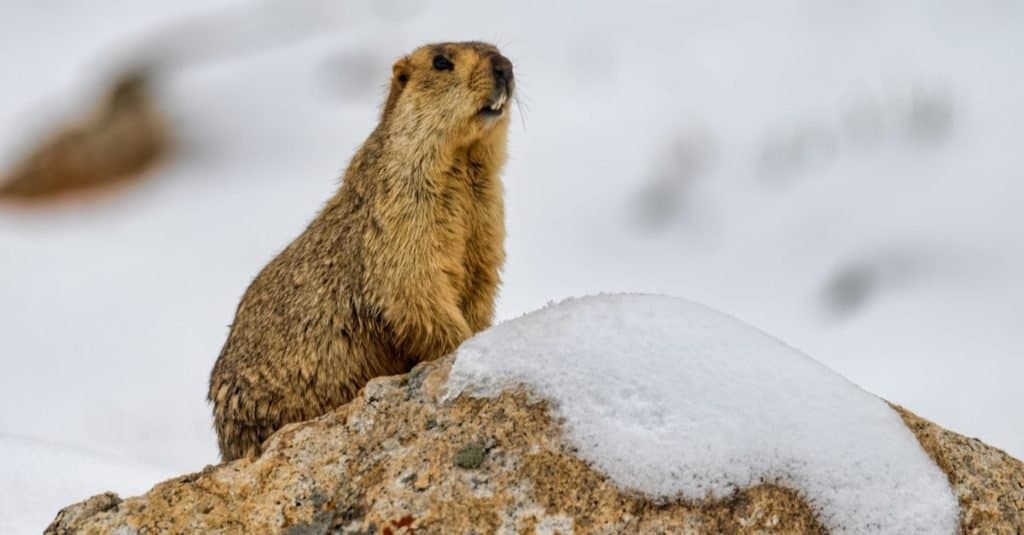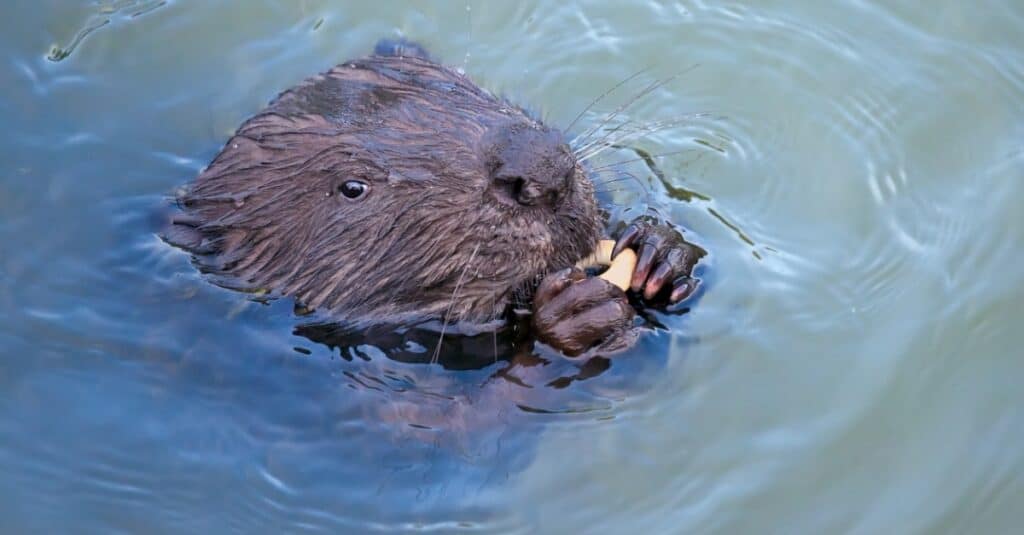“How much wood would a woodchuck chuck if a woodchuck could chuck wood?” The familiar rhyme clues us in to one difference between the marmot and beaver. A woodchuck, also known as a groundhog, is a species of marmot that doesn’t chuck wood but does chuck quite a bit of dirt while digging their burrows. A popular North American tradition waits for the groundhog to emerge from its burrow to announce the arrival of spring. According to legend, if the groundhog sees its shadow, six more weeks of winter are to follow, if not, spring will come early. While marmots wait to see whether winter retreat is necessary, beavers are less invested in the weather since they spent all that time and energy chucking wood to build an elaborate den. As large rodents, they share some features, but let’s take a look at marmot vs beaver and see how they differ.
Comparing a Marmot and a Beaver

| Marmot | Beaver | |
|---|---|---|
| Scientific Name: Family, Genus | Sciuridae, Marmota | Castoridae, Castor |
| Habitat | mountainous areas, meadows, tundras, forest edges, grasslands, steppes | freshwater streams, lakes, ponds, and rivers |
| Shelter | Burrows | Lodges |
| Winter activity | Hibernate in burrows, 8-9 months | Still active, but retreat to their lodges with food stores nearby |
| Diet | Omnivore: grasses, flowers, berries, lichens, mosses, nuts and grains, insects, bird eggs | Herbivore: aquatic plants, leaves, grasses, sedges, roots, herbs, and tree barks |
| Size: body length, weight | 17-28 inches, 4.5-24 pounds | 31-47 inches, 24-66 pounds |
| Coat | long, coarse, brown hues, not waterproof | long, coarse, brown hues, waterproof |
| Tail type | Fluffy | Flat and Scaly |
| Communication | whistle, chirp, chuck, trill | whine, hiss, growl |
Key Differences between Marmot and Beaver

Marmot and beaver maintain different habitats and shelters, winter activity levels, and diet.
©Kamal Hari Menon/Shutterstock.com
The key differences between marmots and beavers are their habitat and shelter type, level of winter activity, diet, and physical traits of size, coat, and tail. Their communication also differs, as they have different vocalizations in response to threats.
These stout brown rodents appear similar to the casual onlooker but when we take a closer look we can see the physical characteristics that set them apart. They live different lifestyles, especially when it comes to the wintertime, and dwell in unique habitats. Let’s continue our exploration of marmot vs beaver below.
Marmot vs Beaver: Classification
Marmot and beaver are both part of the order Rodentia, the largest order of mammals which includes gophers, rats, mice, squirrels, chipmunks, and more. The marmot is part of the family Sciuridae (squirrel family) and belongs to the Marmota genus. It is the largest member of the squirrel family. Other common names for marmot are whistle pig, groundhog, ground squirrel, and rock chuck. There are 15 species of marmot including the alpine marmot, black-capped marmot, forest-steppe marmot, and long-tailed marmot.
The beaver belongs to the family Castoridae, which contains the two main species of beavers and their extinct relatives. Although this family used to include a large group of rodents, it’s now limited to the Castor genus. The two main species of this genus are the North American beaver and the Eurasian beaver, which are further divided into subspecies.
Marmot vs Beaver: Habitat

Beaver live in freshwater ecosystems while marmots are found from the steppes to the tundras
©iStock.com/TatianaMironenko
Marmots are found in mountainous areas, meadows, tundras, forest edges, grasslands, and steppes. They typically build their homes in the safety of small and hard-to-access spaces. Marmot may take advantage of crevices in rocks or may burrow under boulders or other features of the landscape. They dig burrows that are generally about 3 feet deep. You won’t find them out and about during the winter. These animals hibernate, going into deep underground burrows during the colder part of the year. These burrows are much deeper than their home burrows they spend time in the rest of the year, at an average of 16-23 feet deep. Some marmot species build burrows that lead to a large den where an entire family will rest for the winter months. These burrows are passed down through many generations of a single family.
Beavers live exclusively in the freshwater ecosystems of streams, lakes, ponds, and rivers. They gravitate to areas heavy with woods and shrubs for constructing their elaborate habitats. First, they build a dam that will create a large pond of still water. Here, they’ll build their home called a lodge. An impressive feat of engineering and coordination, dam construction starts in summer or early fall. Beavers cut down trees with their teeth and carry them in their mouths to the building site. They carry mud and stones with their fore paws. Sticks are piled in the direction of the water flow and stuffed with grass and mud. With underwater entrances and dry dens, these homes serve to protect beavers from predators and allow them easy access to food. Beavers are keystone species that dramatically affect the surrounding environment with their structures.
Marmot vs Beaver: Dietary Differences

Marmots feed on grasses and more as omnivores, while beavers are strict herbivores who love tree bark.
©Pritha_EasyArts/Shutterstock.com
Although technically omnivorous, marmots are primarily herbivores that obtain their needed nutrients from plant material. They eat grasses, flowers, berries, lichens, mosses, nuts, and grains. They’ll also occasionally eat insects and even bird eggs. They must eat nearly constantly during their active months in order to store up enough reserves for the long 8 to 9 months of hibernation ahead.
Beavers are herbivores that forage plant materials based on seasonal availability. In the warmer months, beavers feed on aquatic plants, leaves, grasses, sedges, roots, and herbs. They switch to woodier plants and barks during the cold winter months. They love aspen trees and will also eat birch, alder, cottonwood, and willow. To cope with the scarcity of winter, beavers will line the bottom of their lodges with branches. When freezing temperatures hit, the waters freeze and they can swim below to find their stored branches when they need something to eat.
Marmot vs Beaver: Appearance

As semi-aquatic animals, beavers have waterproofed fur, but land-dwelling marmot’s fur is fluffy.
©Egoreichenkov Evgenii/Shutterstock.com
Marmots are large rodents with short, thick legs and large claws for burrow digging. They have large heads and white incisors well adapted to processing the vegetation of their diet. Their fur coloration varies depending on species and their surroundings but is typically hues of brown. On average, their body length is 17 to 28 inches and they weigh from 4.5 pounds in the spring to roughly 18 pounds in the autumn. The largest species can get up to 24 pounds. Their weight changes with the seasons. They put on the pounds in preparation for hibernation and shed the weight during the long months of digesting their stored fat. Marmots have fluffy tails that can be short or long depending on the species.
Beavers’ bodies are adapted to their semi-aquatic life. They have streamlined bodies built for marine life that are also bulky enough to carry heavy loads. Their waterproof fur is typically reddish-brown but can vary darker or lighter variations. The outer layer is made up of long, coarse, and glossy guard hairs. And the underfur is dense, short, and fine. They produce oil in their castor glands that they periodically rub through their fur to create a waterproof barrier. They are very large rodents, the second to largest still in existence. On average, they are 31 to 47 inches long and weigh 24 to 66 pounds. Beavers have massive skulls and large, chisel-shaped, yellow incisors for processing vegetation and woody materials. Acting as a support and a rudder, Beaver tails are long with a hairy base and a flat, scale-covered end.
Marmot vs Beaver: Communication
Marmots whistle or chirp when alarmed by predators. A study on yellow-bellied marmots found that they whistled, chucked, and trilled in response to alarming stimuli. Marmots only rarely give alarm calls when exposed to an open environment. They’ll run to a burrow entrance before vocalizing to warn the others.
Beavers often greet one another with whines. They will hiss and growl with a gnashing of their teeth when feeling threatened. Tail slaps serve as an alarm to others, warning of a potential threat in the area. Beavers who hear the tail slap respond by escaping into the lodge or to deeper water.
The photo featured at the top of this post is © Ghost Bear/Shutterstock.com
Thank you for reading! Have some feedback for us? Contact the AZ Animals editorial team.






